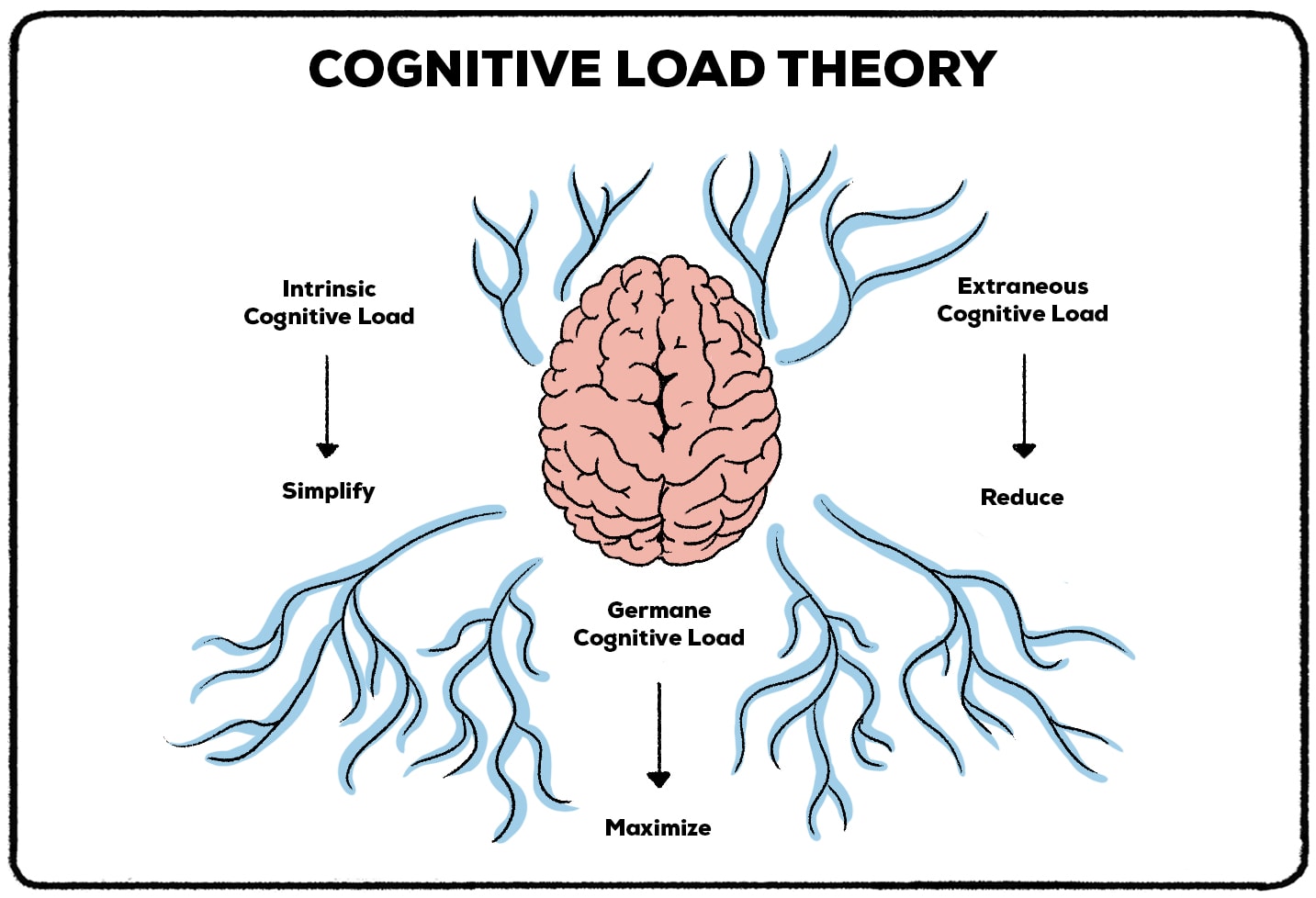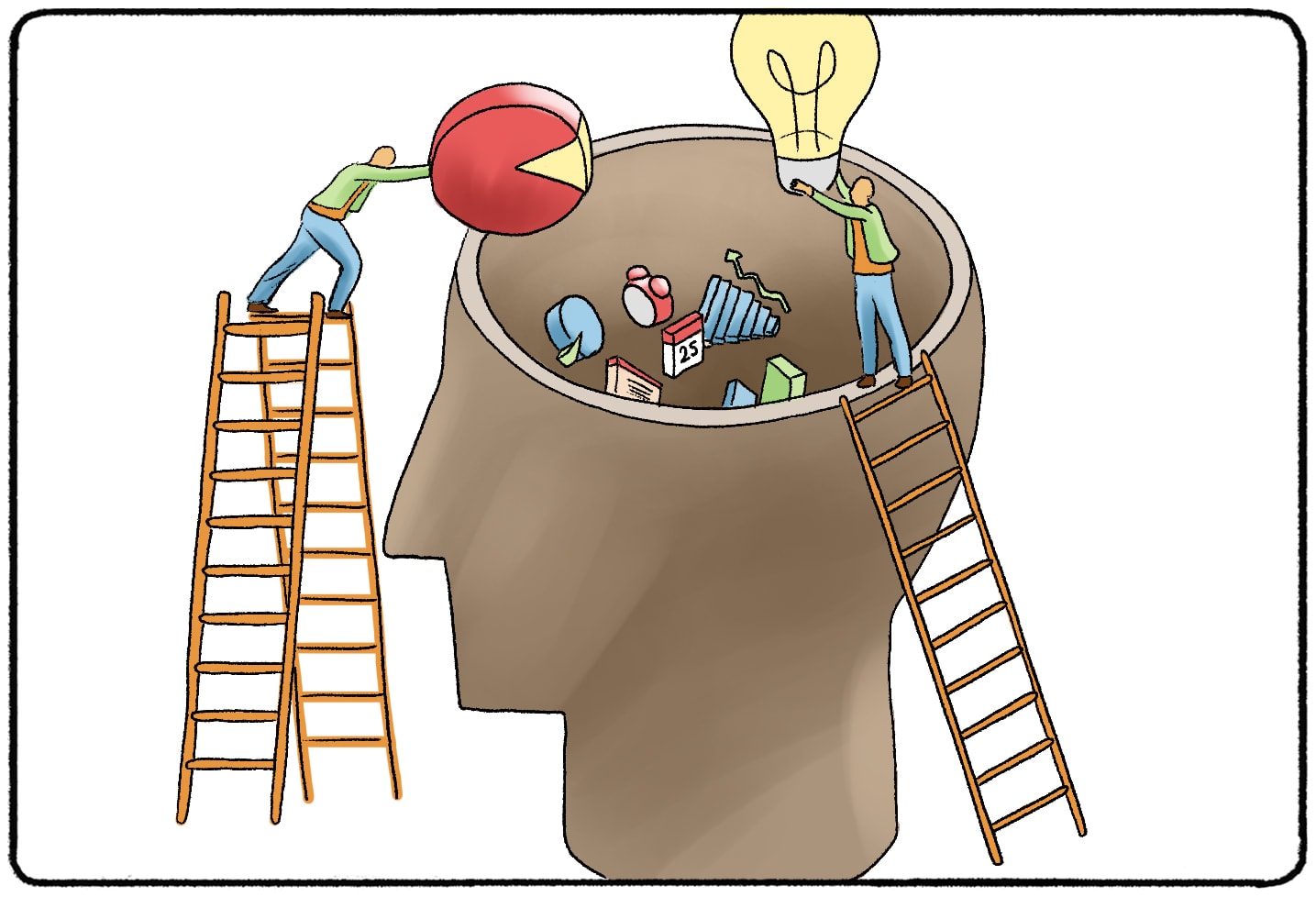This article will describe the Cognitive Load Theory and how you can use it to teach, communicate, and share information complex concepts. Teachers, designers, and even guys like me use the principles of this theory every day, even if we don’t know it. Once you do understand this concept, you will find that your approach to learning and teaching is more intentional, strategic, and effective.
What is Cognitive Load Theory?
Cognitive Load Theory explains the way that we consider working memory while teaching complex concepts or solving problems. A higher cognitive load lowers the percentage of information that is stored in long term memory because you overwhelm your working memory.

When you see something, hear something, or take in any type of information through the senses, it enters your sensory memory. From here, your brain quickly filters out the information that is irrelevant. If you are intentionally devoting your focus to a video game, for example, the sound of the wind or the smell of your food cooking in the next room may be forgotten. The information that is relevant goes to your working memory.
Once the information has moved to your working memory, your brain begins to process it, or forget it. The ultimate goal is to store the information in your long-term memory. Psychologists believe that within long-term memory are structures of information. These structures, called schema, help you relate individual pieces of information to other pieces of information. Within the schema of your video game, for example, you may have information about what each button on your controller does within the context of the game.
Examples of Cognitive Load Theory
The first time you used your controller or played your game, information about each button was in your working memory. You rehearsed and worked with the information long enough that it is now in your long-term memory, and easy to retrieve every time you pick up the controller.
Not all information in your working memory ends up in your long-term memory. This is what Cognitive Load Theory is all about.
How Does Cognitive Load Theory Work?
Long-term memory is like a computer with unlimited data storage. Working memory, on the other hand, can process a few pieces of information at a time. If we fail to come back to the information in our working memory, it will be dropped. Cognitive Load Theory suggests that if we want to learn more effectively, we must respect this reality and only “load up” a few pieces of information into our working memory at a time. If we load up too much, we will be more likely to forget or connect information that we are trying to learn.

There is no set number when it comes to the pieces of information that can be held in our working memory. Our age and development influence how much of a cognitive load that we can take on at once. In general, the simpler materials are, the easier it will be to process them and store them in long-term memory.
Not all pieces of information move through our memory in the same way. The creator of Cognitive Load Theory, John Sweller, also did a lot of work to describe the different types of cognitive load and how instructors can strategize their materials and lessons to lessen the load and help students learn more effectively.
Types of Cognitive Load (With Examples)
There are three types of cognitive load that may or may not be manipulated by teachers or instructors: intrinsic, extrinsic, and germane cognitive load.
Intrinsic
The first type is intrinsic cognitive load. This refers to the level of difficulty of information that teachers want to share. Cognitive load theory as a concept has more of an intrinsic cognitive load than say, 4 x 4 = 16. Instructors cannot manipulate this load, but must be aware of it when introducing concepts.
Extrinsic
Extrinsic cognitive load is the method in which information is taught to students. Distracting or ineffective teaching methods increase extrinsic cognitive load. The goal of teachers, whether they know it or not, is to reduce extrinsic cognitive load and communicate information in a simple, effective way.
Let’s look at two ways that you can teach a simple fact: Christopher Columbus arrived in the Americas in 1492.
One way to teach this information is to say, “In 1492, Columbus sailed the ocean blue” a few times throughout the day. Another way to teach this information is to show students a painting of Christopher Columbus sailing toward the Americas, holding some sort of decree or scroll that says that the year is 1492. Obviously, the first method is going to have less of a cognitive load. Sharing this information through a visual painting with other, irrelevant information is going to overwhelm students. They may remember other details in the painting before remembering that the year 1492 was also included in the details. Students who learn this rhyme will commit it to long-term memory, faster.
Germane
The third type of cognitive load is germane cognitive load. This type of load occurs when we are creating a new schema for a concept. Schema, as I mentioned earlier in the video, are structures in which we organize and hold information. They provide context and make new information related to those schema easier to remember.
Let’s say you enter a woodworking workshop, with no prior knowledge of the craft. One instructor starts the workshop by introducing you to all of the tools you will use in woodworking. Another teacher dives into a complicated project, asking you to grab tools that you are unfamiliar with. The second teacher is increasing your cognitive load - you’ve got to play catch-up as you attempt to build a more complicated schema with information that you do not already have in your long-term memory.
As we can see, the different types of cognitive load can be manipulated. A smart instructor or teacher will keep this in mind as they choose materials and create a lesson plan.
How to Apply Cognitive Load Theory In The Classroom and Beyond
This theory can help you intentionally create educational materials or communicate in a way that people will be able to better understand and learn. Some of the examples that I will be using feel like common sense. Even people who don’t understand Cognitive Load Theory understand that too much information in your brain at once can feel overwhelming. But when you already know the information that you want to share, you may forget how overwhelming the information can be. Understanding this theory will help you design or plan out communication in a way that appeals to everyone.
Educational Materials
This theory is crucial for teachers to understand. After all, your entire goal is to get your students to learn, understand, and remember the materials in the curriculum. Cognitive Load Theory shows how you can more effectively accomplish these goals by not overwhelming your students.
Take Advantage of Auditory and Visual Tools
One of the reasons that I use animations and narration in my videos is because it splits the cognitive load on your working memory. Auditory information is stored in a different place than visual information. If you are a hearing person, you will benefit more from hearing my narration while watching my video, instead of just watching a silent video with captions.
Physically Integrating Information
One way to do this is to physically integrate information together. Let’s think about two different maps of the United States, both created to help students learn which state is where. The first map has the names of the states placed on the actual state. The name “Wyoming” is within the state’s borders. The second map has a number on each of the states. Below the map of the country is a guide to the map: 1 is Alaska, 2 is Arizona, so on and so forth.
Which map makes more sense? The first one. Which map makes it easier to learn? The first one. Why? Students have less of a load - the numbers that connect the shape of the state to the name of the state only clog up their working memory. Keep things simple.
Design
You don’t have to be a teacher or professor to get use out of Cognitive Load Theory. Let’s say you’re designing a poster for a house show or creating a flier for a fundraiser that will be hung around town. Is it better to include all the information that guests will need to know - or would it be more beneficial just to write the event title, date, and a website?
Cognitive Load Theory serves as a reminder that these materials must be simple and concise. Physically integrate information when you can. People seeing this information may already be holding onto information when they see your poster or flier. Do not overwhelm them. Choose the most important message and get it across fast.
Multitasking
Did you know that multitasking is a myth? You may be encouraged by colleagues, managers, or society at large to get everything done at once and “save time.” In reality, however, multitasking doesn’t save time. You cannot hold all of the relevant information from multiple tasks in your working memory. When you switch back and forth between tasks, your mind has to go through a mental shift, leaving behind some of the information from the previous task. These shifts take up more time than you might think.

Reduce your cognitive load by focusing on one task at a time. Put down the phone. Turn off the TV. Give your brain less to work with. Once you are done with your task, you can more effectively put all of the relevant information aside and focus fully on the next task. You’ll save time and reduce your chance of forgetting information as you shift back and forth.
Cognitive Load Theory feels like common sense, but in a world full of distractions, it’s nice to remember every now and again to reduce your load and stay focused.



